RIVERS OF INDIA
Introduction
We’ll navigate the detailed river map of India, including the Ganga River map, the Indus River Map (including 5 Panchnad Rivers), the Brahmaputra River map, the Godavari River map, the Narmada River map etc. along with the direction of the flow (west flowing or east flowing rivers) of respective rivers.
Map of Rivers of India
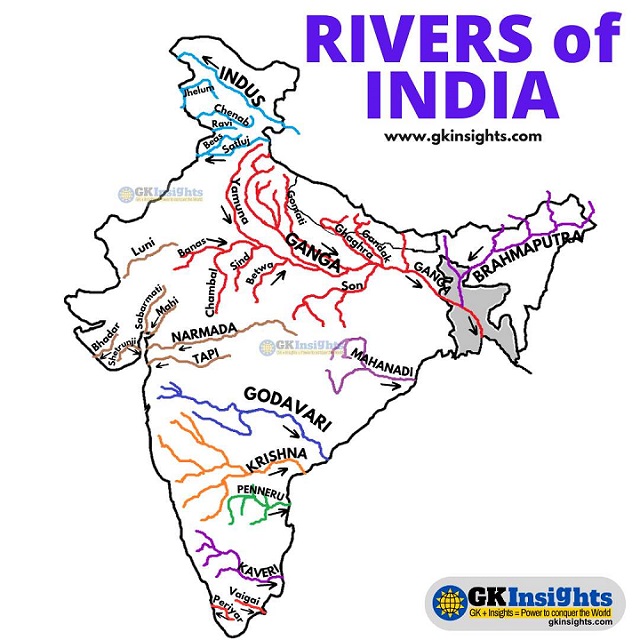
From the northern mountains to the southern plateaus, the major rivers of India flow across various parts of the nation to drain into either Bay of Bengal or Arabian Sea.
List of Rivers of India
| River | Length (Km) | Origin | Major Tributaries |
|---|---|---|---|
| Ganga | 2510 | Gangotri Glacier, Uttarakhand | Yamuna, Ghaghara, Gandak, Kosi, Son |
| Brahmaputra | 2900 (916 in India) | Chemayungdung (Angsi) Glacier, Tibet | Lohit, Dibang, Manas |
| Indus | 2900 (710 in India) | Lake Mansarovar, Tibet | Jhelum, Chenab, Ravi, Satluj |
| Godavari | 1450 | Triambakeshwar, Maharashtra | Pranhita, Indravati, Sabari |
| Krishna | 1400 | Mahabaleshwar, Maharashtra | Bhima, Tungabhadra, Musi |
| Narmada | 1290 | Amarkantak Plateau, Madhya Pradesh | Tawa, Banjar, Sher, Shakkar |
| Mahanadi | 890 | Sihawa, Chhattisgarh | Seonath, Hasdeo, Ib, Ong, Tel, Jonk |
| Tapi | 724 | Betul, Madhya Pradesh | Purna, Girna, Panzara |
| Kaveri | 760 | Talakaveri, Kodagu, Karnataka | Kabini, Bhavani, Hemavati |
Note: Length of Rivers mentioned above is as officially mentioned on this Govt. Website
Major Rivers in India

Ganga River
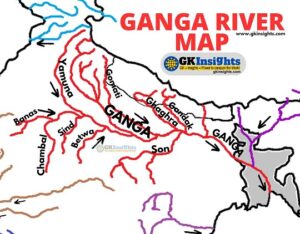
Origin and Tributaries
- Origin in the Gangotri Glacier in Uttarakhand.
- Converges with Yamuna at Prayagraj (Allahabad) to form the holy Ganga-Yamuna Doab, also called Triveni Sangam of Ganga, Yamuna, Saraswati.
- Longest River in India
- Major Tributaries: Yamuna, Ghaghara, Son, Kosi, Gomati, Mahananda
States it passes through
- Uttarakhand, Uttar Pradesh, Bihar, Jharkhand, and West Bengal
- Drains into Bay of Bengal.
- Serves as a natural boundary for several states.
Cultural Importance
- Highly sacred in Hinduism; Pilgrimage destinations: Varanasi, Haridwar, Prayagraj, 5 Prayags etc.
- Ritual bathing for spiritual purification.
- Key rituals and festivals like Kumbh Mela.
- Five sacred confluences called “Prayags“:
- Devprayag (confluence with Alaknanda)
- Rudraprayag (confluence with Mandakini)
- Karnaprayag (confluence with Pindar)
- Nandaprayag (confluence with Nandakini)
- Vishnuprayag (confluence with Dhauliganga)
Environmental Issues
- Challenges in maintaining the river’s purity.
- Pollution due to industrial, human and untreated sewage.
- Government initiatives like Namami Gange for rejuvenation.
Indus River
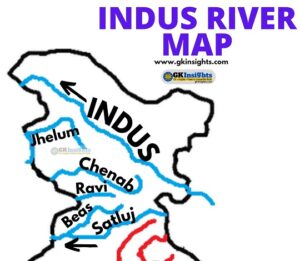
Origin and Tributaries
- Origin: Near Mansarovar Lake in Tibet
- Flow: Flows through Tibet, enters India in the Ladakh region, and continues through Pakistan into Arabian Sea.
- Major Tributaries: Jhelum, Chenab, Ravi, Beas, Satluj (Sutlej) – These 5 are collectively called as Panchnad
States it passes through
- In India: Ladakh region (Union Territory of Ladakh).
- In Pakistan: Punjab, Sindh, and Balochistan provinces.
- Drains into Arabian Sea
Ecological and Cultural Significance
- Associated with the ancient Indus Valley Urban Civilization
- India-Pakistan Relations: Source of historical disputes and conflicts between India and Pakistan, including the Indus Waters Treaty.
Brahmaputra River
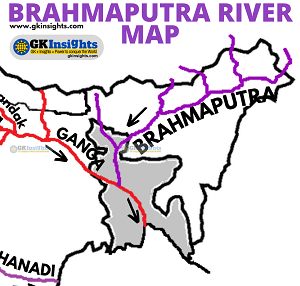
Origin and Tributaries
- Origin: Brahmaputra River originates from the Chemayungdung Glacier in Tibet, China (River also known as the Yarlung Tsangpo there).
- Major Tributaries: Subansiri, Lohit, Kameng, Dibang, Manas, Teesta
States it passes through
- Brahmaputra flows through Tibet, China –> In India: Arunachal Pradesh and Assam –> Bangladesh
- Its sub-basin lies in the states of Arunachal Pradesh, Assam, Nagaland, Meghalaya, West Bengal and Sikkim
- Drains into Bay of Bengal
Ecological and Cultural Significance
- Biodiversity: Supports diverse ecosystems, including the Deltas, Sundarbans Mangrove forest, home to the Bengal tiger
- Cultural Importance: Integral to the cultures of Assam and Bangladesh
- Known as the “Sorrow of Bengal” for its annual flooding.
Water Sharing and Disputes
- Brahmaputra is a transboundary river with a complex geopolitical context
- India and China: Ongoing discussions and tensions regarding water sharing and dam construction in Tibet
- India and Bangladesh: Water sharing agreements and disputes over the distribution of Brahmaputra waters
Major Projects
- Teesta Barrage (India-Bangladesh): Barrage on the Teesta River, a Brahmaputra tributary, with water-sharing disputes between India and Bangladesh.
- Dibang Multipurpose Project: Around 3,000-MW hydroelectric project being constructed on Dibang River in Arunachal Pradesh
Godavari River
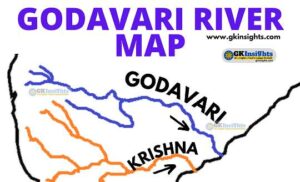
Origin and Tributaries
- Origin: Godavari River originates near Trimbakeshwar in Western Ghats in Nashik district of Maharahstra
- Major Tributaries: Pranhita, Indravati, Sabari, Penganga
States it passes through
- Godavari flows through Maharashtra, Telangana, Andhra Pradesh, Chhattisgarh, and Odisha
- Drains into Bay of Bengal
- Significance: It is often referred to as the “Dakshin Ganga” or the “Ganges of the South” and holds immense cultural, religious, and economic significance.
Ecological and Cultural Importance
- Godavari is referred to as the “Dakshin Ganga” or the “Ganga of the South” and holds immense cultural, religious, and economic significance
- Hindu Pilgrimage: The river is a pilgrimage destination with important ghats and temples along its banks
- Kumbh Mela: The Godavari hosts the Kumbh Mela at Nashik, Trimbak, and Rajahmundry, drawing millions of devotees
Major Projects
- Sriram Sagar Project: Located in Telangana, it is a major irrigation and hydroelectric project on the Godavari
- Polavaram Project: Multipurpose project under construction in Andhra Pradesh for irrigation and flood control
Also Check: Climate of India
Conclusion
Whether you’re preparing for list of rivers of India for examinations like UPSC, seeking information about the 7 holy rivers of India, or simply intrigued by the enchanting riverscape, this article promises to be an enlightening one.
Color coded maps will help you visualise and remember the names and respective flow patterns of the major rivers of India
Also Check:
– Tiger Reserves of India – Map & List
– Elephant Reserves of India – Map & List
FAQs
Which rivers are called as the 7 Holy Rivers in India?
Which are the major West Flowing Rivers of India?
Which is the Longest River in India?
Which is the 2nd Longest River in India?
Which rivers are called as ‘Panchnad’ (Panjnad)?
What are Doabs?
Sindh Sagar Doab – Between Indus and Jhelum
Jech Doab – Between Jhelum and Chenab
Rechna Doab – Between Chenab and Ravi
Bari Doab – Between Ravi and Beas
Bist Doab – Between Beas and Sutlej
